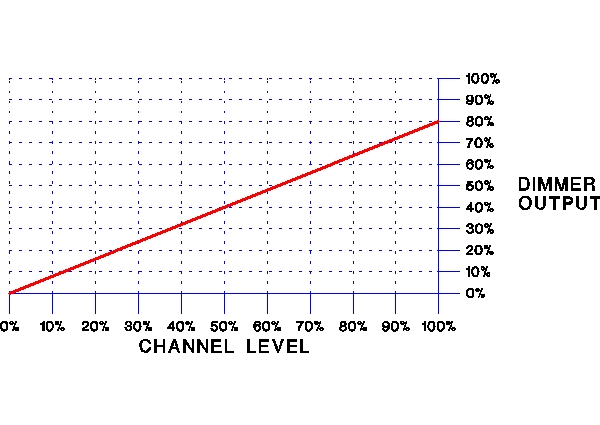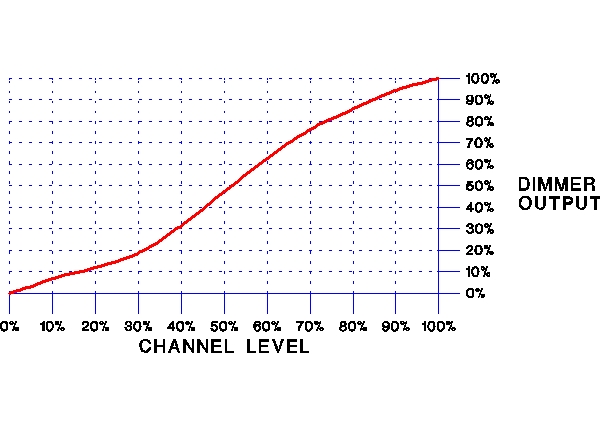|
Terminology:
|
Before you can understand the function of the paperwork, you must first understand patching.
Before you can understand patching, you must first understand channels, dimmers, addresses,
and circuits.
- Channel: A control path that allows the console to vary the output level of one or more dimmers or other
devices. The channel can be physical (controlled by a button, switch or slider) or virtual, (controlled
by a numeric keypad). More properly referred to as "control channels," to differentiate them from "DMX channels" (see "Addresses," below).
- Dimmer: A device which regulates light intensity. Most dimmers do this by electronically controlling
the electricity transmitted to the lamp. Fixtures with discharge lamps may have mechanical dimmers
which regulate the amount of light by hiding it, similar to Venetian blinds. Electronic dimmers
have maximum capacities; since a channel can control any number of dimmers, the capacity
of a channel is limited only by the number of dimmers available to you. Each dimmer has an "address".
- Addresses: Often, especially when soft patching, you will find yourself using devices which must be controlled
by the the console, but which are not dimmers. These devices might include moving lights, LED fixtures, foggers, or any number
of other units. Each controllable attribute of these devices has an "address". To further complicate things. these
addresses are sometimes referred to as "DMX channels," but they should not be confused with the control channels discussed above.
For example: Dimmer #104 might well be patched (and, therefore, controlled by) channel #104, but this does not mean they are the same
thing; at any time, you can repatch any address so as to be controlled by any channel. For more information on addresses, see our
section on DMX.
- Stage Circuit (or Circuit): The wiring which connects the fixture (usually via an outlet) to the patch
panel or dimmer.
- Patching: When we hang lights, we plug them into the most convenient – or least inconvenient – circuits,
but when it comes time to set cues and run rehearsals and performances, it is usually easier to
control lights with similar functions from adjacent channels. The process of connecting circuits, dimmers,
and channels together in a manner that makes their operation logical and convenient is called "patching".
|
|
Types of Patching:
|
There are two types of patching:
- Hard patching:
 This is the connection of circuits to dimmers (and, in early electronic control systems,
dimmers to channels) physically, either through a "patch panel" (see photo) or by plugging cables
directly into the dimmers. Hard patching is rarely done these days; most modern theatres are
"dimmer-per-circuit", with each circuit permanently wired to a dimmer. This is the connection of circuits to dimmers (and, in early electronic control systems,
dimmers to channels) physically, either through a "patch panel" (see photo) or by plugging cables
directly into the dimmers. Hard patching is rarely done these days; most modern theatres are
"dimmer-per-circuit", with each circuit permanently wired to a dimmer.
- Soft patching: This is a virtual connection (rather than a physical one) and is achieved by telling the
computer – because that's what a modern control console is, a computer with a specialized interface –
that every time a level is set for channel X, it's really the level for dimmers Y and Z.
|
|
Proportional Patching, and Dimmer Profiles:
|
Certain variables can give you added flexibility:
- By default, if the channel level is 30% the dimmer output is also 30%. If the channel level is 80%,
then the dimmer output is also 80%, etc.
Most modern consoles allow you to patch proportionally. For example, if a dimmer is proportionally patched at
80%, then when the channel level is 100%, the dimmer output is 80% and when the channel level is 50%, the dimmer
output is 40%, etc., as in this graph:

- Dimmer Profiles: A dimmer profile is an indication, usually represented by a
graph, of how the dimmer will respond to a continuous change in channel levels from 0%-100%. It is
also referred to as a "dimmer curve," even though it is often a straight line, and some consoles refer to it as
a "path". Most consoles will give you a selection of several preset profiles, with the option of designing
your own.
Most consoles default to a "linear" profile:
 There are several other profiles available, including "slow bottom," which is helpful in dealing with
fixtures that tend to "pop" on at relatively low levels, including many less-expensive LED fixtures
(although it should be noted that even the best LEDs will, to some degree pop on, and no profile can
avoid that; the only solution is to lead with fixtures which fade in more smoothly and then follow with
the LEDs):
There are several other profiles available, including "slow bottom," which is helpful in dealing with
fixtures that tend to "pop" on at relatively low levels, including many less-expensive LED fixtures
(although it should be noted that even the best LEDs will, to some degree pop on, and no profile can
avoid that; the only solution is to lead with fixtures which fade in more smoothly and then follow with
the LEDs):
 Other commonly-used profiles include "square law", which is often used by television studios to compensate
for their cameras' sensitivity to small intensity changes at high light levels. In most cases, each dimmer
can be individually profiled.
Other commonly-used profiles include "square law", which is often used by television studios to compensate
for their cameras' sensitivity to small intensity changes at high light levels. In most cases, each dimmer
can be individually profiled.
|
|